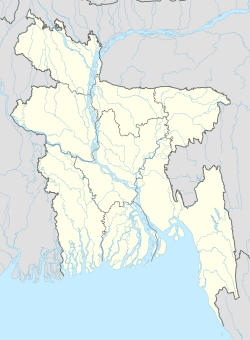Tangail Airdrop
The Tangail Airdrop was a successful battalion-size operation by India's Para Commandos, mounted on 11 December 1971, by the 2nd Battalion (Special Operations) (2 PARA) of the Indian Army's Parachute Regiment during the Indo-Pakistani War of 1971 for the liberation of Bangladesh. The operation's main objective was capturing Poongli Bridge on the Jamuna River, which would cut off the Pakistani 93rd Brigade, which was retreating from Mymensingh in the north to defend the capital of East Pakistan, Dhaka, and its approaches. The paratroop unit was also tasked with linking up with the advancing Maratha Light Infantry on the ground to advance toward the East Pakistani capital.
The Pourasabha (municipal corporation) was established on 1 July 1887, and initially divided the city into five wards:
| Ward No. | Area |
|---|
| 1 | Tangail Kanda Para, Par Dighulia, Akur Takur Para |
| 2 | Korer Betka, Mirer Betka, Nondir Betka, Sabalia, Dorun, Ashekpur, Nagor Jalfai, Boali |
| 3 | Garai, Berai, Kazipur, Bachrakandi, Potol, Bajitpur, Berabuchna, Valluk kandi |
| 4 | Kagmari, Sontosh, Aloa, Boitta, Patuli, Ekrampur |
| 5 | Kalipur, Dighulia, Sakrail, Kaiyamara, Beradoma, Basha, Khanpur |
|
This was later restructured into four wards - Ward No. 1 (Central), 2 (Betka), 3 (Dighulia), and 4 (Santosh) - and then, in 1988, into six wards with the addition of Wards 5 (Zila Sadar) and 6 (Kazipur).
The first city election was held in November 1887, when the citizens elected eight ward commissioners from four wards. The Subdivision Commissioner of Tangail, Shashi Shekhar Dutt, was appointed as the first administrator of Tangail City. The city needed to be better developed, lacking paved roads and roadside lamps; subsequently, the regional zamindars and subdivision board provided financial support to dig ponds, lakes, and canals, creating a safe water supply. [9]
Electricity was established in the city in the early 1930s. Paved roads were constructed in the 1960s, connecting the town to Dhaka. Simultaneously, bridges and culverts were installed. [10]
In 1985, Tangail was promoted from a C to a B Class city. In 1989, the Pourashava was promoted to A-Class. In the 1990s, the city was financed by the Asian Development Bank and the Government of Bangladesh to develop water supply, sanitation, wastewater drainage, bus terminals, supermarkets, and other infrastructure. [11]
In 1999, the city was restructured again into 18 wards (its current organization). [12]



